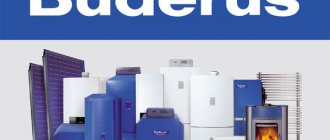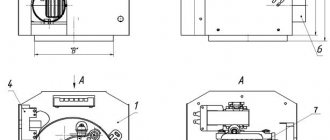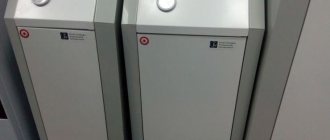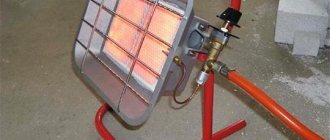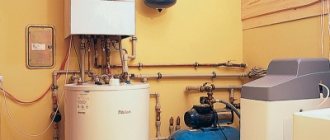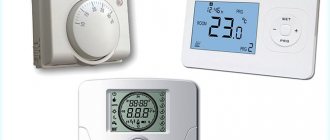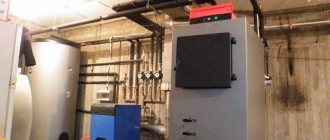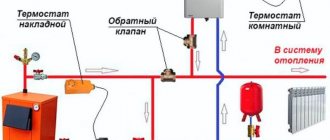Features of gas stoves for summer cottages
Such stoves are the most practical and economical after stoves that burn solid fuel. You can refill a gas cylinder at any gas station, and the performance level of the latest infrared and other types of heaters is superior to classic stoves.
Gas-fired stoves use a burner flame mounted in the combustion chamber. By design, gas furnaces are similar to wood-burning units.
Gas-burner
But here you can install a system for automatically adjusting the operation of the heating device. This feature allows you to further save fuel and maintain a constant temperature in the room.
By installing a container for heating water on the stove, we get the opportunity to install a water heating system. Gas stoves for heating a home are good for everyone, but the most suitable option is to purchase combined devices that can operate on several types of fuel.
Advantages and disadvantages
Many experts argue about these types of heating devices and the advisability of installing them in a country house. For us, consumers, knowledge of all the positive and negative qualities of such structures is required:
- By concluding an agreement with the gas service, you do not have to fill the cylinders with fuel yourself, and interruptions in the operation of the heating device are eliminated;
- in comparison with electricity, the cost of gas is much lower;
- modern designs allow significant fuel savings while maintaining power and thermal energy productivity;
- the operation of the equipment can be fully automated and controlled from a mobile phone at a distance;
- After burning the fuel, only carbon dioxide comes out into the chimney, so there is no need to clean it of soot.
Quite controversial disadvantages include:
- unlike firewood, fuel will require spending money to purchase it;
- if you plan to connect to the natural gas main, you will have to spend time and money on coordination, drafting and acceptance of equipment and its connection to the gas network.
Example of a gas stove
Kinds
Heat capacity level
Gas heating stoves differ in the level of heat capacity. This depends on the ability of the structure to accumulate heat. They can be carried out under the condition of continuous or periodic operation of the equipment.
- Furnaces with a constant heating cycle have thin walls and cannot accumulate thermal energy. But such devices are able to quickly and evenly heat the room of a country house. These devices consume more fuel and are not as economical and are suitable for periodic heating of premises when the owners visit their dacha.
- Heating devices that turn on periodically are a stationary stove, lined with bricks or fenced with reflective screens. The automatic control system lights the burner when the temperature in the room drops, and after turning off, the stone screen gradually releases heat into the atmosphere of the room.
Furnace material
The price and durability of heating stoves depends on the materials from which the firebox and other parts of the unit are made:
- The best option is a cast iron stove with a combustion door made of fireproof glass. But such a design is expensive.
- The next one is the firebox and walls made of stainless or heat-resistant steel. Such equipment will serve for a long time and reliably, but the level of heat capacity of such stoves is much lower, but in terms of the speed of heating the room they are preferable.
- You can make homemade structures from sheet iron or scrap materials and cover them with bricks/ceramic tiles. This equipment will not last as long as a cast iron stove, but in terms of basic characteristics and price, such stoves can compete with industrial designs,
By purpose
Based on this characteristic, we will single out stoves that operate in a house with permanently residing owners and periodic switching on of the stove.
The main purpose of stoves is the same, regardless of the type of fuel - to heat a residential building quickly and maintain a comfortable temperature.
By fuel type
Stoves running on bottled gas are, of course, good. But if there is an interruption in refilling your cylinder, you will have to freeze.
Therefore, the best option, especially if you live in a wooded area, is a combination stove that can operate on all types of solid fuel and liquefied gas.
Such equipment costs a little more, but its characteristics and operating savings quickly pay for the funds spent on the purchase of combined heaters.
Advantages and disadvantages
The range of heaters operating on natural and liquefied gas is presented on the market in a wide range. Each manufacturer, when promoting its product, will prove that its brand of equipment is superior to others. But, no matter what brand the devices belong to, they all have their good and bad sides. The main advantages of gas appliances include:
- Affordable fuel.
- Economical and efficient work.
- Easy to use.
- Equipped with protection systems, which almost eliminates the occurrence of dangerous situations.
- Long service life.
- Do not harm the environment (complete combustion of fuel).
The negative side of use is that it is highly flammable fuel, which if handled carelessly leads to a fire. Portable models take oxygen from the room during operation (normal combustion requires a constant flow of air), so you should consider a ventilation system.
When installing stationary devices, it is necessary to provide a special chimney (a coaxial pipe through which air enters the burner and combustion products are discharged).
Which gas stove is best to choose for your home?
When choosing, be sure to take into account several main factors.
Criterias of choice
| Characteristic | Description |
| Method of obtaining heat | Conventional stoves with burners can be used. Their performance level is significantly higher than that of catalytic furnaces. Catalytic stoves can be installed in rooms with a small volume. Their maximum power is 4.9 kW. |
| Burner type | The industry produces 3 types of these devices:
|
| Organization of air supply to the furnace | Two types of combustion chamber ventilation devices can be installed:
|
| Type of fuel combustion chamber |
|
Manufacturers
Among equipment manufacturers, we will highlight several undisputed leaders.
| Manufacturer | Short description |
| "Master" | These infrared ovens are equipped with ceramic panels. A system for monitoring the oxygen content in the air is being installed. When its value decreases, the device stops operating in automatic mode. |
| "Remington" | The emitter is of the light type. The stove can be connected to bottled and main gas. Equipped with a device for monitoring the state of the atmosphere in the building. |
| "Timberk" | A gas stove for a summer residence with a cylinder with a cylinder is capable of heating a room with a total area of up to 60 m2 and maintaining a comfortable temperature for a long period. |
| "Elitech" | Capable of operating from main gas. Equipped with automation to monitor the work and atmosphere in the building. |
| "Teplodar" | The Russian company produces productive and reliable combination stoves that run on solid fuel and gas. Additionally, the ovens are equipped with a convection system for cold air flows. This design allows you to quickly and evenly heat the air and maintain heat for a long period. |
Gas infrared heater: design and principle of operation
Infrared heaters differ from all others in that they heat not the air, but objects that are in their area of action. Heated objects are already heating the air. Moreover, all this is much faster and more efficient than with air heating. But we must remember that very quickly they create a comfortable temperature in a certain zone - where the radiation is directed. In a few hours the whole room will become comfortable. The specific time depends on the type of walls, the ratio of the volume of the room and the power of the unit. Compared with gas guns, the effect of gas infrared convectors lasts longer: they heat the walls, floor and ceiling, objects, and they, in turn, heat the air in the room.
Gas infrared heaters come in different shapes and types, but the principle of operation is the same for all. The main element is a ceramic plate with many small holes. Ceramics are special, which when heated to a certain temperature emits heat in the infrared range.
Infrared gas heater: operating principle
Gas is supplied to the device inlet, where it is mixed with atmospheric air. At the outlet of the mixer, a flammable gas-air mixture is obtained, which is supplied through a diffuser to the ceramic stove. Ignition occurs using electric or piezo ignition - depending on the type of model and automation. Since gas is supplied over the entire area, it warms up all over, heating more or less uniformly. The temperature of the radiating surface is 550-800°C.
A high-quality gas infrared heater is absolutely safe
What distinguishes a gas infrared heater from other gas appliances is the temperature at which combustion occurs. Since it is very high, there is a very small amount of combustion products. With normally functioning ventilation, the concentration of harmful exhaust does not reach critical levels. And if this happens, the gas analyzer turns off the gas supply. If the gas infrared heater turns off, the best thing to do is to ventilate the room, wait a while, and then try to start the unit again.
How to calculate gas consumption?
The calculation requires knowledge of 2 parameters:
- heating device power;
- total area of the garden house.
A building with a large area will require large fuel reserves. When choosing equipment, we remember the basic rule for choosing a furnace based on power - for each m2 you will need 1 kW of unit power.
- The calculation of the gas required for the season is carried out according to a certain formula - to generate 1 kW of power, 0.112 m3 of gas will be required.
- Now you can easily calculate how much gas is needed to heat a room whose area is, for example, 50 m2.
- Multiply 5 kW by 0.112.
- The result is that 0.56 m3 of gas will be required to heat the room in 1 hour of operation of the furnace.
- Now it is easy to calculate the amount of gas consumption for 1 day and the entire season.
- We will spend 13.44 m3 per day, and for a month of continuous operation we will need 403 m3 of gas.
Selection options
Typically, heating equipment is selected according to thermal power. But gas infrared heaters do not have such a wide range of power - from 2 kW to 4.5 kW. However, 4 kilowatt models are recommended for heating an area of 60 square meters. Few people need more powerful installations. So for ordinary rooms - about 20 square meters in area - they usually take 2.3-2.7 kW heaters. And they heat up the air in 20-30 minutes. Depends on the starting temperature and insulation.
Read also: Onion calorie content per 100 grams raw
What else may be useful:
- Multi-section burner. Most often it has three sections, that is, three operating modes.
- Oxygen monitoring device. Since oxygen is consumed during combustion, and its lack has a negative impact on well-being, oxygen control is a useful thing. Especially if you plan to use the gas infrared heater for a long time or at night.
If there are combustion problems, replace the gearbox with an adjustable one. With its help you can achieve stable operation
All these “bells and whistles” cannot be called superfluous. They are found in those devices that are more often called “gas infrared mobile fireplaces.” Most simple and cheap devices do not have them. All control functions remain with the users.
Ignition type
All more or less reputable models of infrared gas heaters have built-in ignition from a piezoelectric element. To make the equipment independent of the presence of electricity, the piezoelectric element is powered by a battery.
Simpler models must be lit using a match, a torch, or any other source of fire. This is not so safe and convenient, although such units are much cheaper.
Availability of fan and electric convector
Some manufacturers of gas infrared heaters offer models with built-in fans. They increase the rate of heating of the room, as the air moves more actively. This is a really useful thing, it helps speed up warming up by about 20-30%.
But not everything is so perfect. First point: fans only work when connected to electricity. The second is that the cost of equipment with a fan is higher. The difference is a couple thousand. At the same time, you can install a regular small fan on the heater body or next to it. Its price will be three to four times lower, but the effect will be the same. Such a “pair” will not look as aesthetically pleasing as with a built-in “wind blower”, but savings may be more important.
One of the inexpensive options. The heating speed can be increased by placing a fan nearby
Another variation is that an electric convector (Bartolini Primavera I Turbo Plus) is built into the infrared heater. The electric part turns on if the gas part is insufficient. Second application: gas works during the day, electricity at night. This is justified if you are afraid to leave gas equipment running at night. If a night tariff is applied in the region, the cost of heating may not be much more expensive than gas.
Features of operation
How to reduce fuel consumption by using gas stoves for heating your dacha? To do this you will need to follow a few simple recommendations:
- by choosing a condensing type of equipment, the efficiency level of which is over 100%, we get the opportunity to save fuel during operation by up to 23%;
- By purchasing a stove with a closed gas combustion chamber, we achieve savings due to the use of heat from exhaust gases escaping into the chimney;
- furnaces equipped with an automatic and remote control system for equipment operation allow the temperature to be lowered and raised. By lowering the temperature by 5-7 degrees, during the period when no one is at the dacha, we achieve significant fuel savings;
- By equipping the stove with a heat exchanger, we get the opportunity to install a heating system in all rooms and use hot water for domestic needs.
Classification by execution
Depending on the design, the following types of gas heaters are distinguished.
Portable cylinders
As a rule, they are made in the form of a housing with gas equipment and space for securing the cylinder (there are also models with the cylinder connected via a hose). Sizes can vary: from miniature ones for heating tents on hikes to large and powerful ones for heating large rooms.
Due to their size, powerful models are equipped with wheels for easy transportation. An ignition button and a combustion intensity regulator are installed on the body of the device.
Portable gas heaters operate only on bottled gas.
There are two types of gas: natural and liquefied (can consist of both natural and various mixtures, for example, propane-butane). The first type is supplied through highways and used in stationary installations.
Liquefied is a gas in a liquid state, it has a higher density and is pumped into cylinders , therefore it is more convenient for portable use. A device designed only for natural gas will not work with liquefied gas.
Heating devices of this type are used in utility rooms, garages, at industrial facilities for temporary heating of houses, at street events, and are widely used during hiking: in cases where the room is small and constant heating is not required.
Due to the specific nature of the application, portable gas convectors are equipped with safety systems that stop the operation of the device when the heater tips over, there is no flame or low gas pressure.
Stationary
Heating devices for permanent installation are usually produced in the form of flat panels , since they do not have space for placing a cylinder. Equipped with brackets for mounting on walls and ceilings.
They usually run on natural gas, but some models can use liquefied fuel cylinders.
Important!
Such “omnivorousness” is ensured either by
changing the nozzles (for liquefied gas the spray hole in them is smaller) or by special burners designed for both types of gas.
Stationary heaters can have either an open combustion chamber or a closed one:
Open - not isolated from the room in which the device is used.
The air for gas combustion comes from the room itself, so for these devices it is necessary to ensure high-quality ventilation of the room (otherwise the air will be depleted of oxygen during use).
A traditional chimney is used to remove combustion products.
Such devices are often used as an alternative to a central heating system in places where regular heating is required for a long time: country houses, apartments.
About security
During the operation of gas appliances, it is important to comply with all fire safety requirements.
We pay special attention to the rules for maintaining gas cylinders:
- They must be checked periodically and comply with standards. It is mandatory to install reducers that reduce the pressure of the gas leaving the cylinder.
- At the first sign of a leak or a faint smell of gas in the room, be sure to turn off the gas supply and turn the stove back on only after identifying and eliminating the problem.
Gas infrared heaters from a cylinder: operating principle
The use of infrared heaters has some peculiarities. For example, in order for the device to cover a larger area, it must be placed as high as possible above the floor surface. In this case, the range of its influence will be as wide as possible, and the room will be quite warm.
The gas infrared heater consists of the following elements:
- body made of metal;
- heat exchanger;
- divider;
- automatic control unit;
- gearbox
As for the sizes of heaters, they can be very different: from small compact models to large devices designed for large rooms, warehouses, garages, etc.
Design features of the Ballu outdoor heater
Note! Keep in mind that some distance must be maintained between the heater and the gas cylinder. Otherwise, there is a risk of an explosion caused by a flame inside the device itself.
If we talk about the principle of operation of the device, we can distinguish the following processes:
- the flow of gas from the cylinder into the reducer, where the gas pressure decreases, after which it enters the heater nozzle;
- mixing of gas with air and their joint entry into the ceramic panel;
- uniform gas combustion and, as a result, a complete absence of combustion by-products;
- heating the ceramic component of the heater and further transfer of heat through infrared radiation.
As a result of the fact that the device heats the objects around it, the overall air temperature also increases. Therefore, infrared gas heaters are perfect for a summer house, garage or greenhouse.
Operating principle of a gas infrared heater
